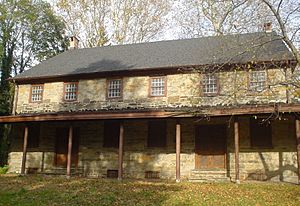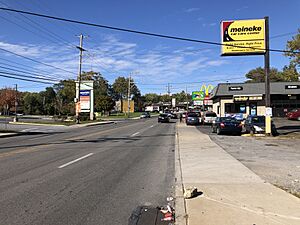Darby, Pennsylvania facts for kids
Quick facts for kids
Darby, Pennsylvania
|
|
|---|---|

Darby Friends Meeting House, built 1805
|
|

Location in Delaware County and the U.S. state of Pennsylvania
|
|
| Country | United States |
| State | Pennsylvania |
| County | Delaware |
| Area | |
| • Total | 0.84 sq mi (2.18 km2) |
| • Land | 0.84 sq mi (2.18 km2) |
| • Water | 0.00 sq mi (0.00 km2) |
| Elevation | 79 ft (24 m) |
| Population
(2020)
|
|
| • Total | 10,715 |
| • Density | 12,725.65/sq mi (4,912.05/km2) |
| Time zone | UTC-5 (EST) |
| • Summer (DST) | UTC-4 (EDT) |
| ZIP Code |
19023
|
| Area codes | 610 and 484 |
| FIPS code | 42-18152 |
Darby is a small town, called a borough, in Delaware County, Pennsylvania, United States. It's located about 5 miles (8 km) southwest of Center City Philadelphia. Darby is right along the Darby Creek. It's important to know that the Borough of Darby is different from the nearby area called Darby Township.
Contents
History of Darby, Pennsylvania
Early Settlement in the 1600s
Darby was first settled in 1682 by seven families who were part of the Quaker group. These families were led by John Blunston. He was a Quaker who believed in ending slavery and supported fair trade. The name "Darby" comes from the English city of Derby, which is pronounced "Darby." Many of the first settlers came from that area in England.
Darby officially became a borough on May 3, 1853. Its population has grown over the years. In 1900, about 3,429 people lived there. By 2010, the population had reached 10,687.
John Blunston, one of Darby's founders, arrived in Pennsylvania in October 1682. He was involved in buying and selling land, farming, and trading goods. As an early Quaker, Blunston worked closely with William Penn, who founded Pennsylvania. Blunston was also an active political leader in early Pennsylvania.
He served in the Colonial Assembly from 1683 to 1688. During this time, he strongly supported the Assembly's rights. In 1685, Blunston was on a committee that argued against the Provincial Council making laws without the Assembly's approval. He also led the Assembly's effort to question Chief Justice Nicholas More. Blunston returned to the Assembly in 1695. He was elected Speaker of the Assembly three times: in 1697, 1699, and 1700. He helped write a new government plan for the Province. He left the Assembly after 1701.
Darby in the 1700s and 1800s
Besides his work in the Assembly, John Blunston was a Provincial Councilor from 1700 to 1723. He also served as a justice of the peace for Chester County. Blunston was very active with the Darby Quaker Meeting House. He was one of the Quakers who worked to stop the slave trade among Friends. He encouraged people to avoid buying products made by enslaved people. He called these "stolen products," which was an early idea of "Fair Trade."
Darby is home to some historic places. It has the fifth-oldest all-volunteer Fire Department. The Darby Free Library is one of the oldest libraries in the United States, started in 1743. The Darby Friends Burial Ground is the oldest cemetery in Pennsylvania that has been used continuously since it opened in 1682.
In 1819, the first group in Pennsylvania to discourage the unnecessary use of strong drinks was formed in Darby. It was called the "Darby Association for Discouraging the Unnecessary Use of Spirituous Liquors." This group met at the Darby Friends Meetinghouse.
In 1833, three of the fourteen women who started the Pennsylvania Female Anti-Slavery Society were members of the Darby Friends Meeting. This group worked to end slavery.
Darby in the 1900s
In 1919, during a time of racial tension across the country, there was an incident in Darby. A 17-year-old Black boy named Samuel Gorman was arrested. He was accused of a crime, and there was an attempt to harm him by a crowd.
Geography of Darby
Darby covers an area of about 0.8 square miles (2.1 square kilometers). All of this area is land. The climate in Darby is humid subtropical. This means it has hot, humid summers and mild winters. Average monthly temperatures range from about 34°F (1°C) in January to 78°F (26°C) in July.
Population and People
| Historical population | |||
|---|---|---|---|
| Census | Pop. | %± | |
| 1860 | 780 | — | |
| 1870 | 1,205 | 54.5% | |
| 1880 | 1,779 | 47.6% | |
| 1890 | 2,972 | 67.1% | |
| 1900 | 3,429 | 15.4% | |
| 1910 | 6,305 | 83.9% | |
| 1920 | 7,922 | 25.6% | |
| 1930 | 9,899 | 25.0% | |
| 1940 | 10,334 | 4.4% | |
| 1950 | 13,154 | 27.3% | |
| 1960 | 14,059 | 6.9% | |
| 1970 | 13,729 | −2.3% | |
| 1980 | 11,513 | −16.1% | |
| 1990 | 11,140 | −3.2% | |
| 2000 | 10,299 | −7.5% | |
| 2010 | 10,687 | 3.8% | |
| 2020 | 10,715 | 0.3% | |
| Sources: | |||
Population in 2020
In 2020, Darby had a population of 10,715 people. The town is very diverse. Most residents are Black or African American. There are also White, Asian, Native American, and multiracial residents. A small percentage of the population is Hispanic or Latino.
| Race / Ethnicity (NH = Non-Hispanic) | Pop 2000 | Pop 2010 | Pop 2020 | % 2000 | % 2010 | 2020 |
|---|---|---|---|---|---|---|
| White alone (NH) | 3,722 | 1,706 | 895 | 36.14% | 15.96% | 8.35% |
| Black or African American alone (NH) | 6,143 | 8,330 | 8,849 | 59.65% | 77.95% | 82.59% |
| Native American or Alaska Native alone (NH) | 11 | 26 | 25 | 0.11% | 0.24% | 0.23% |
| Asian alone (NH) | 84 | 74 | 78 | 0.82% | 0.69% | 0.73% |
| Pacific Islander alone (NH) | 7 | 3 | 0 | 0.07% | 0.03% | 0.00% |
| Some Other Race alone (NH) | 29 | 16 | 70 | 0.28% | 0.15% | 0.65% |
| Mixed Race or Multi-Racial (NH) | 205 | 304 | 330 | 1.99% | 2.84% | 3.08% |
| Hispanic or Latino (any race) | 98 | 228 | 468 | 0.95% | 2.13% | 4.37% |
| Total | 10,299 | 10,687 | 10,715 | 100.00% | 100.00% | 100.00% |
Population in 2010
In 2010, the population density was about 12,624 people per square mile. There were about 3,405 households. About 41% of these households had children under 18 living there. The average household size was 2.88 people.
The population was fairly young, with about 33% of residents under 18 years old. The median age was 32 years. The median income for a household was $26,938. About 20% of the population lived below the poverty line.
Education in Darby
The William Penn School District serves Darby. This district was created in 1972. Before that, Darby was part of the Darby-Colwyn School District.
Schools in the area include:
- Park Lane Elementary School (Kindergarten to 6th grade)
- Walnut Street Elementary School (Kindergarten to 6th grade)
- Penn Wood Middle School (7th to 8th grade)
- Penn Wood High School, Cypress Street Campus-Freshman Academy (9th grade) in Yeadon
- Penn Wood High School, Green Avenue Campus (10th to 12th grade) in Lansdowne
Darby is also home to Blessed Virgin Mary (BVM). This is a private Catholic school.
Transportation in Darby
Roads and Highways
As of 2018, Darby had about 14 miles (22.7 km) of public roads. Most of these roads are maintained by the borough. The Pennsylvania Department of Transportation (PennDOT) maintains some main roads.
U.S. Route 13 is the main highway in Darby. It runs through the center of the borough along MacDade Boulevard.
Trains and Trolleys
Darby has public transportation services provided by SEPTA.
- The SEPTA Subway–Surface Trolley Lines number 11 and 13 stop at the Darby Transportation Center.
- The SEPTA Wilmington/Newark Line commuter train stops at the Darby station.
In the past, Darby had other train stations. The Baltimore and Ohio Railroad (now CSX) had two stations. One was at Main and 6th Streets, where the SEPTA Route 11 trolley crosses today. The other was Boone Station, at Poplar Street and Lawrence Avenue. The Pennsylvania Railroad station was located where the current SEPTA station for the Wilmington/Newark Line is now.
Notable People from Darby
Many interesting people have connections to Darby:
- Mike Barbarick (born 1959), a soccer player.
- Stephen Barrar (born 1954), a former member of the Pennsylvania House of Representatives.
- John Bartram (1699–1777), a Quaker and an early American botanist. He was born in Darby and is buried there. His botanical garden, the oldest in the U.S., is nearby.
- John Drew, an executive in Negro league baseball.
- W.C. Fields, a famous comedian and actor, was born in Darby in 1880.
- Monica Horan, an actress known for her role in Everybody Loves Raymond.
- Jeff LaBar, a rock guitarist for the band Cinderella.
- Peter O'Keefe, a former member of the Pennsylvania House of Representatives.
- John James Pearson (1800–1888), who served in the U.S. House of Representatives.
- Estelle Ricketts, the first published African-American woman composer.
- James N. Robertson, a Pennsylvania state representative and a brigadier general.
- John Stanford, a former superintendent of the Seattle school district and a U.S. Army officer.
- Annis Boudinot Stockton, the first woman poet to have her work published in the British American colonies.
- Chris Wheeler, a sports broadcaster.
Images for kids
See also
 In Spanish: Darby para niños
In Spanish: Darby para niños







